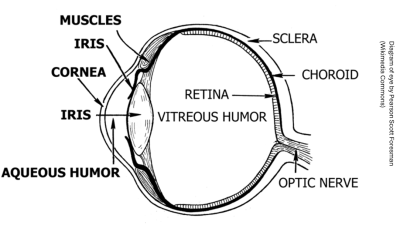About vitrectomy
A vitrectomy is an operation to remove the vitreous from the eye.
The vitreous is a transparent gel-like structure that lies behind the iris (the coloured part of your eye) and lens. It sits in front of the retina (the light sensing tissue at the back of your eye).
The operation usually takes 1 to 2 hours, but the duration varies, depending on complexity.

Why we may recommend a vitrectomy
We recommend a vitrectomy for patients for the following reasons.
- Diabetic vitreous haemorrhage. This is a bleed into the vitreous gel, due to diabetic changes at the back of the eye. Removal of the vitreous gel helps to resolve the bleeding. This helps to improve vision, enables us to remove any necessary scar tissue and allows us to perform laser treatment. It may also reduce the risk of future bleeds.
- Retinal detachment. This is a separation of the retina from its original position in the eye.
- Macular hole. This is a hole in the central part of the retina.
- Epiretinal membrane. This is scar tissue on the surface of the retina.
- Endophthalmitis. This is a severe infection of the entire eyeball.
- Removal of remaining lens fragments after complicated cataract surgery.
- A foreign body in the eye.
During the operation
How we remove the vitreous
To remove the vitreous we do the following.
- We make 3 small incisions (cuts) in the sclera (the white tissue that forms the eyeball).
- We insert instruments into the eye through these incisions. These instruments usually comprise a light source, a cutting device (to remove the vitreous), and an infusion of fluid (to maintain eye pressure during the operation).
Once we have removed the vitreous gel, we may perform further procedures such as:
- Laser or cryotherapy (freezing treatment) to the retina. We do this for diabetic retinal changes or retinal detachments.
- Removal of scar tissue or foreign bodies or lens fragments
What happens to the vitreous gel
We do not replace your vitreous gel. We substitute your vitreous with one of the following substances after the vitrectomy:
- air (naturally absorbed within 1 to 7 days)
- a gas bubble (naturally absorbed within 2 to 10 weeks)
- silicone oil (this does not absorb and we may need to remove it at a later date)
Once the substance (air or gas) absorbs, the vitreous cavity gradually fills with aqueous humour (a clear fluid which is constantly produced by the eye).
Sedation during the operation
We usually perform the operation while you are under local anaesthetic with sedation. This means you will be awake during the operation, but we will numb your eye. We will give you medicine into your veins to help you feel relaxed.
Sometimes we perform it while you are under general anaesthetic (asleep).
Risks and side effects
Risks
Vitrectomy has a good success rate, but there are some risks associated with the surgery.
These include:
- serious eye infection (endophthalmitis). This affects 1 in 1000 patients. We can treat this with oral (by mouth) and local antibiotics (usually eye drops; occasionally we add ointments).
- retinal tears or detachment. We can treat these with laser or surgery, as required.
- increase in eye pressure. In most cases we can manage this with eyedrops or tablets. In rare cases we may offer surgery.
- inflammation or bleeding in the eye. We can treat this with eyedrops or tablets.
- cataract (cloudiness of the natural lens of the eye). This is a risk unless you have already had cataract surgery.
Side effects
Common side effects include:
- Red eye due to mild bruising on the surface of the eye. This clears in 1 to 2 weeks.
- Sore and gritty eye due to disturbance to the eye surface. This clears in 1 to 2 days.
Cataracts
Most patients who have a vitrectomy develop a cataract, affecting their vision, an earlier age than they would have otherwise. This may mean they need a cataract operation.
If a cataract is already present, we may perform cataract surgery at the same time as the vitrectomy.
After the operation
You can expect the following after your vitrectomy.
- Your vision will be blurry for a few weeks.
- If you have an air or gas bubble, or silicon oil in your eye, your vision will be blurry until the gas or air bubble naturally reabsorbs, or we remove the oil using surgery.
- You may notice a ‘curved edge’ of the air or gas bubble in your line of vision as the bubble gradually reabsorbs.
- We may ask you to adopt a particular posture (head position) for a few days after surgery. This will encourage the gas or oil to lie against the correct part of the retina.
- We will give you eye drops to use following the surgery, to help to reduce inflammation and prevent infection.
- Sometimes we prescribe additional drops or tablets to keep your eye pressure low.
- Your eye is likely to be red for up to 4 weeks.
Everyday activities after your vitrectomy
You must avoid contact sports and swimming for 1 month after your vitrectomy.
If you require a general anaesthetic for another operation during this time, you must let the anaesthetist know that you have a gas bubble in the eye.
Flying
You must not fly whilst you have air or gas in your eye, as it may expand due to aircraft atmospheric pressure.
This can lead to a dangerous rise in your eye pressure.
Time off work
You will need to take approximately 2 weeks off work (depending on your job) to recover after your vitrectomy.
Driving
This depends on the vision in your other eye. Your doctor will advise you.
Contact information
Kingston Hospital Royal Eye Unit, 9am to 5 pm Monday to Friday
Telephone: